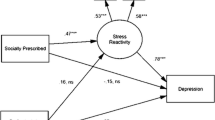Abstract
The association between dimensions of perfectionism and state and trait anxiety was examined in three studies. Study 1 and Study 2 were correlational studies that investigated the link between dimensions of perfectionism (i.e., self-oriented, other-oriented, and socially prescribed perfectionism) and the Endler Multidimensional Anxiety Scales (EMAS). Taken together, the results indicated that self-oriented and socially prescribed perfectionsim are correlated significantly with both the cognitive-worry and autonomic-arousal components of state anxiety. As for the trait anxiety measures, self-oriented perfectionism was associated with the ambiguous and social evaluation facets in Study 1, and socially prescribed perfectionism was associated with the ambiguous and daily routines facets in Study 2. The purpose of Study 3 was to examine perfectionism and state anxiety under conditions of high versus low ego involvement. It was found that socially prescribed perfectionism was associated with higher state anxiety, but only in the high ego involvement condition. Self-oriented perfectionism was unrelated to state anxiety in either experimental condition. Overall, the findings indicate that socially prescribed perfectionism is the dimension linked most closely with components of state and trait anxiety, especially under conditions of ego threat. The results are discussed in terms of the need for an interactional approach to the study of the social aspects of both perfectionism and anxiety.
Similar content being viewed by others
References
Beck, P., & Burns, D. (1979). Anxiety and depression in law students: Cognitive intervention.Journal of Legal Education, 30, 270–290.
Blankstein, K. R., & Flett, G. L. (1990). Cognitive components of test anxiety: A comparison of assessment and scoring methods.Journal of Social Behavior and Personality, 5, 187–202.
Blankstein, K. R., Flett, G. L., Boase, P., & Toner, B. (1990). Thought listing versus endorsement measures of self-referential thinking in test anxiety.Anxiety Research, 2, 103–111.
Blankstein, K. R., Flett, G. L., Watson, M. S., & Koledin, S. (1990). Test anxiety, self-evaluative worry, and sleep disturbance in college students.Anxiety Research, 3, 193–204.
Blankstein, K. R., Toner, B., & Flett, G. L. (1989). Text anxiety and the contents of consciousness: Thought listing and endorsement measures.Journal of Research in Personality, 23, 269–286.
Breen, L. J., Endler, N. S., Prociuk, T. J., & Okada, M. (1978). Person X situation interaction in personality prediction: Some specifics of the person factor.Journal of Consulting and Clinical Psychology, 46, 367–368.
Burns, D. D. (1980).Feeling good: The new mood therapy. New York: The New American Library.
Burns, D. D. (1983). The spouse who is a perfectionist.Medical Aspects of Human Sexuality, 17, 219–230.
Butler, R. (1987). Task-involving and ego-involving properties of evaluation: Effects of different feedback conditions on motivational perceptions, interest, and performance.Journal of Educational Psychology, 79, 474–482.
Carver, C. S., & Scheier, M. F. (1988). A control-process perspective on anxiety.Anxiety Research, 1, 17–22.
Deffenbacher, J. L. (1986). Cognitive and physiological components of test anxiety in real-life exams.Cognitive Therapy and Research, 10, 635–644.
Derogatis, L. R. (1983).Manual for the SCL-90-R. Towson, MD: Clinical Psychometric Research.
Derogatis, L. R., & Melisaratos, N. (1983). The brief symptom inventory: An introductory report.Psychological Medicine, 13, 595–605.
Duval, S., & Wicklund, R. A. (1972).A theory of objective self-awareness. New York: Academic Press.
Endler, N. S. (1975). A person-situation interaction model of anxiety. In C. D. Spielberger & I. G. Sarason (Eds.),Stress and anxiety, Vol. 1 (pp. 145–164). Washington, DC: Hemisphere.
Endler, N. S. (1983). Interactionism: A personality model but not yet a theory. In M. M. Page (Ed.),Nebraska Symposium on Motivation (1982): Personality—current theory and research (pp. 155–200). Lincoln, NE: University of Nebraska Press.
Endler, N. S. (1988). Hassles, health, and happiness. In M. P. Janisse (Ed.),Individual differences. stress. and health psychology (pp. 24–56). New York: Springer.
Endler, N. S., Edwards, J. M., & Vitelli, R. (1991).Endler Multidimensional Anxiety Scales (EMAS): Manual. Los Angeles, CA: Western Psychological Services.
Endler, N. S., Edwards, J. M., Vitelli, R., & Parker, J. D. A. (1989). Assessment of state and trait anxiety: Endler Multidimensional Anxiety Scales.Anxiety Research, 2, 1–14.
Endler, N. S., Hunt, J. McV., & Rosenstein, A.J. (1962). An S-R Inventory of Anxiousness.Psychological Monographs, 76, Whole #536 (pp. 1–33).
Endler, N. S., Lobel, T., Parker, J. D. A., & Schmitz, P. (1991). Multidimensinality of state and trait anxiety: A cross-cultural study comparing American, Canadian, Israeli, and German young adults.Anxiety Research, 3, 252–272.
Endler, N. S., & Magnusson, D. (1976). Toward an interactional psychology of personality.Psychological Bulletin, 83, 956–974.
Endler, N. S., & Okada, M. (1975). A multidimensional measure of trait anxiety: The S-R Inventory of General Trait Anxiousness.Journal of Consulting and Clinical Psychology, 43, 319–329.
Endler, N. S., & Parker, J. D. A. (1990a). Multidimensional assessment of coping: A critical evaluation.Journal of Personality and Social Psychology, 58, 844–854.
Endler, N. S., & Parker, J. D. A. (1990b). State and trait anxiety, depression, and coping styles.Australian Journal of Psychology, 42, 207–220.
Endler, N. S., & Parker, J. D. A. (1990c). The analysis of a construct that does not exist: Misunderstanding the multidimensional nature of trait anxiety.Educational and Psychological Measurement, 50, 265–271.
Endler, N. S., Parker, J. D. A., Bagby, R. M., & Cox, B. J. (1992). The multidimensionality of state and trait anxiety: The factor structure of the Endler Multidimensional Anxiety Scales.Journal of Personality and Social Psychology, 60, 919–926.
Endler, N. S., & Shedletsky, R. (1973). Trait versus state anxiety, authoritarianism and ego threat versus physical threat.Canadian Journal of Behavioural Science, 5, 347–361.
Flett, G. L., Blankstein, K. R., Hewitt, P. L., & Koledin, S. (1992). Components of perfectionism and procrastination in college students.Social Behavior and Personality, 20, 85–94.
Flett, G. L., & Hewitt, P. L. (1992, June).Perfectionism in anxiety and depression: An investigation with the Perfectionism Cognitions Inventory. Paper presented at the World Congress of Cognitive Therapy, Toronto, Ontario.
Flett, G. L., Hewitt, P. L., & Blankstein, K. R. (1991, August).The Perfectionism Cognitions Inventory: Development. validation. and association with depression. Paper presented at the 99th annual meeting of the American Psychological Association, San Francisco, California.
Flett, G. L., Hewitt, P. L., Blankstein, K. R., & Dynin, C. B. (1994). Dimensions of perfectionism and Type A behaviour.Personality and Individual Differences, 16, 477–485.
Flett, G. L., Hewitt, P. L., Blankstein, K. R., & Koledin, S. (1991). Dimensions of perfectionism and irrational thinking.Journal of Rational-Emotive and Cognitive-Behavior Therapy, 9, 185–201.
Flett, G. L., Hewitt, P. L., Blankstein, K. R., & Mosher, S. W. (1991). Perfectionism, self-actualization, and personal adjustment.Journal of Social Behavior and Personality, 6, 5, 147–160.
Flett, G. L., Hewitt, P. L., & Dyck, D. G. (1989). Self-oriented perfectionism, neuroticism, and anxiety.Personality and Individual Differences, 10, 731–735.
Flood, M., & Endler, N. S. (1980). The interaction model of anxiety: An empirical test in an athletic competition.Journal of Research in Personality, 14, 329–339.
Frost, R. O., & Henderson, K. J. (1991). Perfectionism and reactions to athletic competition.Journal of Sport and Exercise Psychology, 13, 323–335.
Frost, R., & Marten, P. (1990). Perfectionism and evaluative threat.Cognitive Therapy and Research, 14, 559–572.
Frost, R., Marten, P., Lahart, C., & Rosenblate, R. (1990). The dimensions of perfectionism.Cognitive Therapy and Research, 14, 449–468.
Gerlsma, C., Emmelkamp, P. M. G., & Arrindell, W. A. (1990). Anxiety, depression, and perception of early parenting: A meta-analysis.Clinical Psychology Review, 10, 251–277.
Hamachek, D. E. (1978). Psychodynamics of normal and neurotic perfectionism.Psychology, 15, 27–33.
Hewitt, P. L., & Flett, G. L. (1990). Perfectionism and depression: A multidimensional analysis.Journal of Social Behavior and Personality, 5, 423–428.
Hewitt, P. L., & Flett, G. L. (1991a). Dimensions of perfectionism in unipolar depression.Journal of Abnormal Psychology, 100, 98–101.
Hewitt, P. L., & Flett, G. L. (1991b). Perfectionism in the self and social contexts: Conceptualization, assessment, and association with psychopathology.Journal of Personality and Social Psychology, 60, 456–470.
Hewitt, P. L., & Flett, G. L. (1993). Dimensions of perfectionism, daily stress, and depression: A test of the specific vulnerability hypothesis.Journal of Abnormal Psychology, 102, 58–65.
Hewitt, P. L., Flett, G. L., & Blankstein, K. R. (1991). Perfectionism and neuroticism in psychiatric patients and college students.Personality and Individual Differences, 12, 273–279.
Hewitt, P. L., Flett, G. L., Turnbull-Donovan, W., & Mikail, S. (1991). The Multidimensional Perfectionism Scale: Reliability, validity, and psychometric properties in psychiatric samples.Psychological Assesment: A Journal of Consulting and Clinical Psychology, 3, 464–468.
Hewitt, P. L., & Genest, M. (1990). The ideal self: Schematic processing of perfectionistic content in dysphoric university students.Journal of Personality and Social Psychology, 59, 802–808.
Hewitt, P. L., Mittelstaedt, W., & Wollert, R. (1989). Validation of a measure of perfectionism.Journal of Personality Assessment, 53, 133–144.
Higgins, E. T. (1987). Self-discrepancy: A theory relating self and affect.Psychological Review, 94, 319–340.
Jackson, D. N. (1970). A sequential system for personality scale development. In C. D. Spielberger (Ed.),Current topics in clinical and community psychology (pp. 61–96). New York: Academic Press.
Kendall, P. C. (1978). Anxiety: States, traits, situations?Journal of Consulting and Clinical Psychology, 46, 280–287.
Liebert, R. M., & Morris, L. W. (1967). Cognitive and emotional components of test anxiety: A distinction and some initial data.Psychological Reports, 20, 975–978.
Lobel, T. E., Gilat, I., & Endler, N. S. (1993). The Gulf War: Distressful reactions to Scud missiles attacks.Anxiety, Stress, and Coping, 6, 9–23.
Miller, A., & Hom, H. L., Jr. (1990). Influence of extrinsic and ego incentive value on persistence after failure and continuing motivation.Journal of Educational Psychology, 82, 539–545.
Miller, D. T. (1976). Ego involvement and attributions for success and failure.Journal of Personality and Social Psychology, 34, 901–906.
Mothersill, K., Dobson, K., & Neufeld, R. (1986). The interactional model of anxiety: An evaluation of the differential hypothesis.Journal of Personality and Social Psychology, 51, 640–648.
Nekanda-Trepka, C. (1984). Perfectionism and the threat to self-esteem in clinical anxiety. In R. Schwarzer (Ed.),The self in anxiety. stress, and depression (pp. 125–132). North-Holland: Elsevier Science.
Pacht, A. R. (1984). Reflections on perfection.American Psychologist, 39, 386–390.
Phillips, J. B., & Endler, N. S. (1982). Academic examinations and anxiety: The interaction model empirically tested.Journal of Research in Personality, 16, 303–318.
Quadland, M. C. (1980). Private self-consciousness, attribution of responsibility, and perfectionistic thinking in secondary erectile dysfunction.Journal of Sex and Marital Therapy, 6, 47–55.
Sarason, I. G. (1975). Anxiety and self-preoccupation. In I. G. Sarason & C. D. Spielberger (Eds.),Stress and anxiety, Vol. 2 (pp. 27–44). New York: Wiley.
Sarason, I. G. (1984). Stress, anxiety and cognitive interference: Reactions to tests.Journal of Personality and Social Psychology, 46, 929–938.
Sarason, I. G. (1988). Anxiety, self-preoccupation and attention.Anxiety Research, 1, 3–7.
Spielberger, C. D. (1966). The effects of anxiety on complex learning and academic achievement. In C. D. Spielberger (Ed.),Anxiety and behavior. New York: Academic Press.
Spielberger, C. D. (1972). Anxiety as an emotional state. In C. D. Spielberger (Ed.),Anxiety: Current trends in theory and research (pp. 23–49). New York: Academic Press.
Spielberger, C. D., Gorsuch, R. C., & Lushene, R. E. (1970).Manual for the State-Trait Anxiety Inventory. Palo Alto, CA: Consulting Psychologists Press.
Stewart, A. J. (1982). The course of individual adaptation to life changes.Journal of Personality and Social Psychology, 42, 1100–1113.
Stewart, A. J. (1989). Social intelligence and adaptation to life changes. In R. S. Wyer, Jr., & T. K. Srull (Eds.),Advances in Social Cognition Vol. 11 (pp. 187–196). Hillsdale, NJ: Erlbaum.
Tresselt, M. E., & Mayzner, M. S. (1966). Narrative solution times for a sample of 134 solution words and 378 associated anagrams.Psychonomic Monograph Supplements, 1, 293–298.
Van Houdenhove, B. (1986). Prevalence and psychodynamic interpretation of premorbid hyperactivity in patients with chronic pain.Psychotherapy and Psychosomatics, 45, 195–200.
Weiser, L., Endler, N. S., & Parker, J. D. A. (1991). State anxiety, trait anxiety, and coping style in Mexican and Canadian young adults.Anxiety Research, 4, 125–139.
Wine, J. (1971). Test anxiety and direction of attention.Psychological Bulletin, 76, 92–104.
Author information
Authors and Affiliations
Rights and permissions
About this article
Cite this article
Flett, G.L., Endler, N.S., Tassone, C. et al. Perfectionism and components of state and trait anxiety. Current Psychology 13, 326–350 (1994). https://doi.org/10.1007/BF02686891
Accepted:
Issue Date:
DOI: https://doi.org/10.1007/BF02686891




